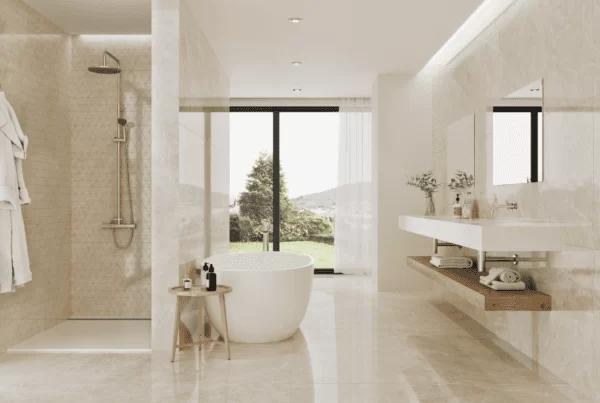Various textures and finishes of full bodied porcelain tiles
Porcelain tiles have been in use for a few decades, as wall cladding, flooring, work surfaces and much more. Their applications have been increasing along with their popularity, and this is because so much research has gone into developing these sorts of tiles, and so they come in a very wide variety of different functionalities, characteristics, shapes, sizes, designs, textures and many more ways of variation, which makes them suitable for most requirements of people, and for most functionalities.
Unglazed vs glazed porcelain tiles
Porcelain tiles come with various surface finishes, and this is because porcelain is made out of a mixture of raw materials, with clay being the most abundant material, alongside smaller amounts of other materials gathered such as Aluminium Silicate, Feldspar, Flint, Silica, sand, and other sorts of compounds that contribute to the desirable features that porcelain boasts. This mixture is then moulded into the desired shape and size, and fired at extremely high temperatures reaching 1,400 degrees Celsius, while being compressed under very high pressures, in order to form a very dense and strong compound, with no pores or dents to allow any porosity, which explains why porcelain has an absorbance rate of less than 0.5%, which is very low compared to the 4.5% absorbance rate of ceramic tiles. Even though they are made in a similar way, there are major differences with the ingredients used in making the mixture of each type of tiles, and so they are shaped, fired and compressed under slightly different conditions, which is what allows porcelain to be more stain resistant, have a wider range of colours, and be much more durable under most conditions, including outdoor and driveway usage.
Porcelain and ceramic tiles however cannot be used as tiles or as work surfaces as soon as they are completely fired in the kiln, as the surface of the stone will be too rough and uneven to be fully suitable for use – they must be textured in certain ways first. With some porcelain tiles, manufacturers choose to glaze them with specially modified materials, that give the tiles a very nice finish. However, a more traditional method is to finish off the surface of the tile without adding a glaze…and even though these methods have developed far over the years, the main concept still exists and is still a very popular option amongst customers when it comes to choosing between tiles.
Full Bodied and Double Loaded porcelain tiles
Before the finish comes onto the tile though, we must explore how the unglazed tiles differ from glazed porcelain during production, and there are two different methods in specifically producing these kinds of tiles. Full bodied tiling is one of the two main methods of producing unglazed porcelain tiles. This is where various kinds of minerals, pigments and metal oxides are added to the porcelain mixture before it is moulded and fired, and so these contribute to creating the various colours and patterns found on the tile in the finished product. However, if the additional components originate from valuable materials, then it would be very expensive to add them into the whole mixture, and so this is where the double loading technique kicks into action. This innovative idea involves pressing the moisturised tile base onto a sturdy template with a pattern integrated within, so that the decorative design would be stamped onto the surface of the stone whilst it is being fired within the kiln. Once that is over, the small recessive sections made on the stone will be filled with liquidised substances of various colours, most commonly slip clay, and they will be left to settle, and this will create a beautiful pattern that runs across the tile.
Rectifying tiles
After firing is over, and before the finishing of the surface of the tile, the porcelain produced must undergo some sort of rectification, as it will look uneven when it initially comes out of the kiln. The size may not be very accurate to the one demanded, the edges may not be straight, and there may be a few cracks, chips or even pressure marks found near the edges of the tiles. As a result, manufacturers must make sure to accurately cut the tile into the exact size that is required. Then, the tile edges are also straightened up by snipping small intrusive sections off the sides of the tiles and making sure that there are no odd marks left on there.
Textured porcelain tiles
Following the production and rectification of the unglazed tiles, some tiles are meant to serve a very textured design, in order to provide a lot of resistance under wet conditions and so they become very anti-slip, such as porcelain tiles used for the outdoors, driveways, wet rooms, warehouses, and other such applications. These tiles are only smoothed out using special grinding equipment, so that they have some inclines and recessive parts, creating a lovely natural atmosphere, but combine that with a beautiful modern tile design.
Honed porcelain tiles
Tile honing machines can also be used to create a different sort of tile to the textured ones and double loaded ones, and this is the honed finish, which is a matt finish, that is very anti-slip (but less than the textured) and has a sway effect in its finish. These kinds of machines spin a diamond smooth blade very swiftly, and moved across the surface, so that the surface becomes ground, and even though it displays a natural effect as well, it has a nice sway in the surface which imitates the movement of the machine used and is also very smooth and comfortable to walk on. This type of tile is suitable for regularly used kitchens, offices and other busy applications that need to be comfortable to live with, but also resistant to any slipping.
Therefore, we can see that even with unglazed tiles, we can have very beautiful looking tiles, and there are three main options to go for, and fulfil the requirements and priorities with.



